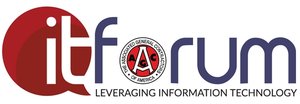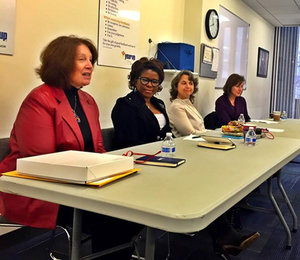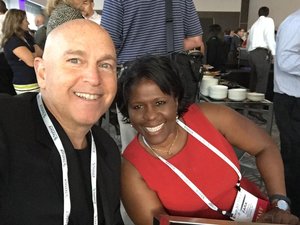
“Fast and furious.”
That term easily defines the development, deployment, and proliferation of new technologies in the design and construction industry over the last decade. And Charlotte Fara Francis has had a front row seat for all of it. Now in her 11th year as Chief Information Officer for the 26,000-member Associated General Contractors of America (AGC), Francis has helped to steer the old school, formerly tech-averse, national trade group onto the information superhighway.
And in an industry as traditionally white as it is male, Francis also stands out as a black female leader, a distinction that only gets more exclusive when information technology enters the discussion. This week, as AGC prepares for its upcoming 98th Annual Convention and Trade Show in Las Vegas (March 7-9), followed by the event’s first-ever One-Day Tech Summit (March 10), BuiltWorlds had the opportunity to talk with Francis about her unique window on our industry’s extraordinary, ongoing transformation.
BW: Fara, thanks for speaking with us. Now, you have been at AGC since 2006. How would you describe the organization’s view of technology then compared to today?
FF: Thanks for the opportunity to share. When I first started here, the description I always heard was, “Construction is slow to embrace technology.” So there was still some skepticism. But within a few years, leadership noticed a steady, consistent and positive interest in technology from our membership, and we welcomed the change. Recognizing the uniqueness of this industry — low margins, with a heavy focus on cost — it’s been refreshing to see how the application of technology has been embraced. Construction IT leaders have tapped into more sophisticated, best-in-class technology to add value to their organizations and to their projects, while an effort birthed by AGC’s membership — the agcXML initiative — has worked to improve construction software interoperability. Of course, the growth of building information modeling (BIM), mobile apps, and lately AR/VR, all also stand out.
“We knew there was a curious, national audience of I.T. leaders out there who were hungry for information”
BW: Among membership and chapters, how has the use and acceptance of technology grown and spread over that time? Have you been surprised by the pace of that growth?
FF: I have been very surprised and impressed with how so many of our chapters have become very savvy users. They have consistently pushed technology forward, creating their own IT steering committees and adding IT sessions to their annual meetings. So, kudos to our members who have adopted and implemented everything from back-office software platforms to robust jobsite apps to enhance efficiency and productivity. They helped to spur the surge in mobile app development for various niches: time cards and reporting, punch lists, safety apps, and so on. That growing interest was why we created the annual AGC-IT Forum Conference, which we’ve hosted now every summer since 2009. We knew there was a curious, national audience of IT leaders out there who were hungry for information, and seeking a place where they could share best practices and collaborate with experts and colleagues. And we were right. That conference has grown every year.
BW: What technology advance in our industry has most surprised you?
FF: Mobile apps have been a surprise. Every couple of months, we seem to hear of yet another new, cool app that integrates well with back-office software, that offers timely functionality and an easier way to compile data. Another is Virtual Reality (VR). The idea that the customer can now see the building and do a “virtual walk-through” before it is constructed is a pretty impressive advancement for our industry. Also, drones have been an interesting addition. We still await more federal guidelines, of course, but it has been great to see how contractors might save time by using drones to monitor a job site and capture photos at significant elevations. Drones can and will be a key efficiency tool on project jobsites.
- Below, Francis participates on a ‘YearUp’ panel. At right, with NoteVault CEO Peter Lasensky.
BW: Looking ahead, what area of R&D are you most optimistic about for our industry?
FF: I have had conversations with various thought leaders on this… and 3D printing is an area that stands out. There is even R&D ongoing at one major university where they are using 3D printing for project buildout… Safety apps also are taking off. At AGC, we closely monitor injury rates and worker fatalities nationwide, so we’ve been encouraged to see software developers focus on apps, sensors, and wearable technologies that can help… Cybersecurity also is now moving up the list of critical strategic initiatives at organizations, as it should. Our industry is not immune to breaches and other intrusions. Cybersecurity should not be an IT problem or issue, it should be a strategic conversation.
Another area that we are still hopeful for is in software interoperability and open integration standards. Our agcXML initiative started us off on this important path, and it now resides with the Construction Open Standards Alliance (COSA), where I serve on the board. It is a group of like-minded construction technologists who see the great value that open integration standards can bring to this industry.
BW: Personally, you are easily one of the most prominent black females in the AEC industry. Do you feel that plays any role in how you approach your job?
FF: For me, honestly, it is more… How can I be that CIO that leads with integrity and performs with a high degree of competency? How can I help other women interested in growing their careers? How can I help my team to become better and to find value in their work? So, yes, I’m involved in Women in IT and serve in their mentor/protégé program. I also sit on the board and serve as membership chair for the Society for Information Management (SIM), DC Chapter. Hopefully, these experiences give visibility to women in tech leadership positions, and serve as a reminder and encouragement to others.
BW: Thank you for your time, Fara. Have a good conference this March.
FF: You are most welcome. Hopefully we’ll see you all in Las Vegas, too.




Discussion
Be the first to leave a comment.
You must be a member of the BuiltWorlds community to join the discussion.